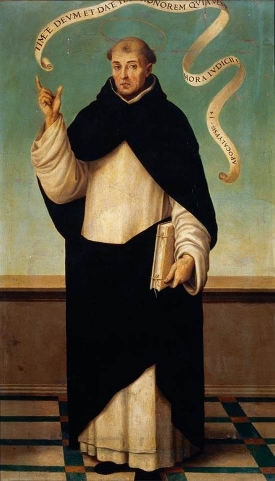
Saint Vincent Ferrer - Patron Saint of Our Church
Saint Vincent FerrerSaint Vincent Ferrer was born on 23 January 1350 (some histories say 1357) in Valencia, Spain. His father, William Ferrer, was an Anglo-Scot ennobled for his part in the conquest of Valencia and his mother, Constantia Miguel, was Spanish from a family similarly ennobled. Vincent was named after the patron Saint of Valencia, St Vincent Martyr. It is believed the family was piously Christian and that Vincent’s parents were noted for their virtue and their giving to the poor, much of which they subsequently entrusted to Vincent.
At the age of 18, given the choice by his father, Vincent chose to join the Dominican Order to serve God. He continued studies in Barcelona, Spain, then taught philosophy in Lerida, Spain before returning to further study in Barcelona and later in Toulouse, France. In 1379, after ordination to the priesthood, he was called to serve Cardinal Pedro de Luna, the papal legate of Pope Clement VII to the Court of Aragon (the papacy, in dispute as part of the Papal Schism, then based in Avignon, France). For some five years in the late 1380s he lectured in theology at Valencia Cathedral.
After this he continued service for Cardinal de Luna. In the 1390s Vincent converted a rabbi later to become Paul, Bishop of Burgos. Queen Yolanda of Aragon appointed him her confessor. When Pedro de Luna was raised to the papacy in 1394 as Benedict XIII, he named Vincent his confessor and an Apostolic Penitentiary. Vincent continued to work amongst the people and refused higher office, including becoming a cardinal.
Around 1398 Vincent narrowly escaped death from a severe fever, but during his illness saw an apparition of Christ, St Dominic and St Francis. Following his miraculous recovery his mission became to preach penance and preparation for the day of judgement. For the next twenty years or so Vincent preached ceaselessly across western Europe, in Spain, France, Italy, Germany, Switzerland, the low countries, England, Scotland and Ireland. As well as being a preacher and theologian, Vincent was also very much involved in public affairs and was often called upon to be mediator and peacemaker. He was the advisor of princes, bishops and city administrations. After celebrating Mass and giving a lengthy homily Vincent would bless the sick and it is reported that he was responsible for numerous miraculous cures.
In his last two years, Vincent settled in Brittany, France. His life was austere. He would rise early in the morning to say daily Office, he celebrated Mass daily, he often preached for several hours. After lunch he would tend the sick. In the evening he would prepare his sermon for the following day. He was always fasting and his bed was often the floor.
In Vannes, Brittany on 5th April 1419, after 10 days of severe and painful illness, Vincent died. His remains were interred in the Cathedral there. He died having seen the effective end of the Papal Schism that had caused him so much sadness, when Martin V was elected as Pope of the re-united Church in 1417 - even though this involved the excommunication of his former mentor, Benedict XIII.
Vincent was canonised Saint Vincent Ferrer by Pope Calixtus III on 3rd June 1455 in the Dominican Basilica of Santa Maria sopra Minerva in Rome. At his canonisation some 800 validated miracles were reported.
Saint Vincent Ferrer’s feast day is 5th April. He is the patron saint of building and construction workers.
Text: Rob Haines with acknowledgements to:
www.newadvent.org
www.wikipedia.org
www.catholic.org
www.ewtn.org
www.sqpn.org
